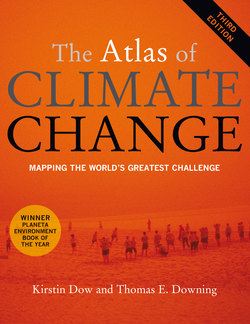Читать книгу The Atlas of Climate Change - Professor Kirstin Dow - Страница 16
На сайте Литреса книга снята с продажи.
ОглавлениеDefinitions for chemical names, units, technical terms, and regional groupings recognized in international treaties are provided below, along with explanatory notes on impacts, vulnerability and adaptation, theory, predictions, forecasts and scenarios, and the IPCC suite of scenarios. Sources for the definitions are provided at the end of the book. Chemical names CCl4 Carbon tetrachloride. CFC Chlorofluorocarbon – covered under the 1987 Montreal Protocol on Substances that Deplete the Ozone Layer and used for refrigeration, air conditioning, packaging, insulation, solvents, or aerosol propellants. Since they are not destroyed in the lower atmosphere, CFCs drift into the upper atmosphere where, given suitable conditions, they break down ozone. These gases are being replaced by other compounds, including HCFCs and HFCs, which are greenhouse gases covered under the Kyoto Protocol. CH4 Methane. CO2 Carbon dioxide. CO2e Carbon dioxide equivalent. See under Technical terms. Halocarbons Compounds containing carbon and one or more of the three halogens: fluorine, chlorine, and bromine, including the greenhouse gases CFCs, CCl4, and HFCs. HCFC Hydrochlorofluorocarbon. HFC Hydrofluorocarbon. N2O Nitrous oxide. O3 Ozone in the lower atmosphere (troposphere) that acts as a greenhouse gas. It is created both naturally and by photochemical reactions involving gases resulting from human activities (“smog”). In the stratosphere, ozone is created by the interaction between solar ultraviolet radiation and molecular oxygen (O2). In the upper atmosphere (stratosphere) ozone plays a decisive role in the stratospheric radiative balance. Its concentration is highest in the ozone layer. Depletion of stratospheric ozone results in increased ultraviolet radiation. Units GW Gigawatt. GWth Gigawatt thermal. micron One millionth of a meter. Tonnes Metric tons, equivalent to 1,000 kg or 2,204.62 lb. A gigatonne is one billion (109) tonnes. Technical terms Anaerobic A life or process that occurs in, or is not destroyed by, the absence of oxygen. Anthropogenic Resulting from or produced by human beings. Calving The breaking away of a mass of ice from a floating glacier, ice front, or iceberg. Carbon dioxide equivalent (CO2e) A measure used to compare the emissions from various greenhouse gases, based on their global warming potential (GWP). The carbon dioxide equivalent for a gas is derived by multiplying the tonnes of the gas by the associated GWP. Carbon equivalent A measure used to compare the emissions of different greenhouse gases, based on their global warming potential (GWP). Convert from CO2 to carbon by multiplying by 12/44. Carbon sequestration The removal and storage of carbon from the atmosphere in carbon sinks. Carbon sink Reservoirs for carbon, such as forests and oceans, processes, activity or mechanisms that store more carbon than they release. CDM Defined in Article 12 of the Kyoto Protocol, the Clean Development Mechanism is intended to meet two objectives: (1) to assist Parties not included in Annex I in achieving sustainable development and in contributing to the ultimate objective of the convention; and (2) to assist Parties included in Annex I in achieving compliance with their quantified emission limitation and reduction commitments. Climate In a narrow sense this is usually defined as the “average weather” or the statistical description of the mean and variability of relevant quantities over a period of time ranging from months to thousands or millions of years. The classical period is 30 years, as defined by the World Meteorological Organization (WMO). The relevant quantities are most often surface variables such as temperature and precipitation. Climate in a wider sense is the state of the climate system. Climate change A statistically significant variation in either the mean state of the climate or in its variability, persisting for an extended period (typically decades or longer). Climate change may be due to natural internal processes or external radiative forcing, or to persistent anthropogenic changes in the composition of the atmosphere or in land use. The UNFCCC, in its Article 1, defines it as: “a change of climate which is attributed directly or indirectly to human activity that alters the composition of the global atmosphere and which is in addition to natural climate variability observed over
Definition of Key Terms
16
